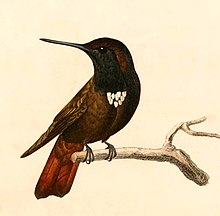| Black-hooded sunbeam | |
|---|---|

| |
| Conservation status | |
 Least Concern (IUCN 3.1) | |
| CITES Appendix II (CITES) | |
| Scientific classification | |
| Domain: | Eukaryota |
| Kingdom: | Animalia |
| Phylum: | Chordata |
| Class: | Aves |
| Clade: | Strisores |
| Order: | Apodiformes |
| Family: | Trochilidae |
| Genus: | Aglaeactis |
| Species: | A. pamela |
| Binomial name | |
| Aglaeactis pamela (d'Orbigny, 1838) | |

| |
The black-hooded sunbeam (Aglaeactis pamela) is a species of hummingbird in the "brilliants", tribe Heliantheini in subfamily Lesbiinae. It is endemic to Bolivia.
Taxonomy and systematics
The black-hooded sunbeam is monotypic.
Description
The black-hooded sunbeam is about 12 cm (4.7 in) long including its 15 mm (0.59 in) straight black bill. Males weigh about 5.2 g (0.18 oz) and females 5.8 g (0.20 oz). The adult male is mostly purplish black, with glittering golden green to bluish green on the lower back and rump and a white tuft in the center of the breast. The tail is rufous with dusky tips to the feathers. Adult females are colored like the male but are duller overall and with less iridescent lower back and rump. Juveniles are somewhat browner than adults, with a reduced breast tuft and an olive cast to the tail.
Distribution and habitat
The black-hooded sunbeam is found only in the Andes of northern Bolivia, mainly in the departments of La Paz and Cochabamba. In elevation it mostly ranges between 2,500 and 4,200 m (8,200 and 13,800 ft) but there are records as low as 1,800 m (5,900 ft). It inhabits cloud forest and humid to semihumid montane scrublands.
Behavior
Movement
The black-hooded sunbeam is believed to be sedentary but might make seasonal elevational movements.
Feeding
The black-hooded sunbeam feeds primarily on nectar; it forages at all levels and clings to flowers to feed rather than hovering. It also feeds on small arthropods.
Breeding
The black-hooded sunbeam's breeding season is thought to span from September to March. Its breeding phenology, nest, and eggs have not been described.
|
Songs and calls Listen to black-hooded sunbeam on xeno-canto |
Vocalization
Though the black-hooded sunbeam's vocalizations are not well known, it has been reported giving a "high pitched zeet-zeet-zeet", and other calls during antagonistic encounters.
Status
The IUCN has assessed the black-hooded sunbeam as being of Least Concern. Though it has a small range and its population size is not known, the latter appears to be stable. "At least in the short term, Black-hooded Sunbeam seems to be little affected by human activities".
References
- ^ BirdLife International (2016). "Black-hooded Sunbeam Aglaeactis pamela". IUCN Red List of Threatened Species. 2016: e.T22687798A93169808. doi:10.2305/IUCN.UK.2016-3.RLTS.T22687798A93169808.en. Retrieved 26 April 2022.
- "Appendices | CITES". cites.org. Retrieved 14 January 2022.
- ^ Gill, F.; Donsker, D.; Rasmussen, P., eds. (January 2022). "Hummingbirds". IOC World Bird List. v 12.1. Retrieved 15 January 2022.
- HBW and BirdLife International (2020) Handbook of the Birds of the World and BirdLife International digital checklist of the birds of the world Version 5. Available at: http://datazone.birdlife.org/userfiles/file/Species/Taxonomy/HBW-BirdLife_Checklist_v5_Dec20.zip retrieved 27 May 2021
- ^ Schulenberg, T. S. and C. W. Sedgwick (2020). Black-hooded Sunbeam (Aglaeactis pamela), version 1.0. In Birds of the World (T. S. Schulenberg, Editor). Cornell Lab of Ornithology, Ithaca, NY, USA. https://doi.org/10.2173/bow.blhsun1.01 retrieved 26 April 2022
| Taxon identifiers | |
|---|---|
| Aglaeactis pamela |
|
| Ornismya pamela | |
